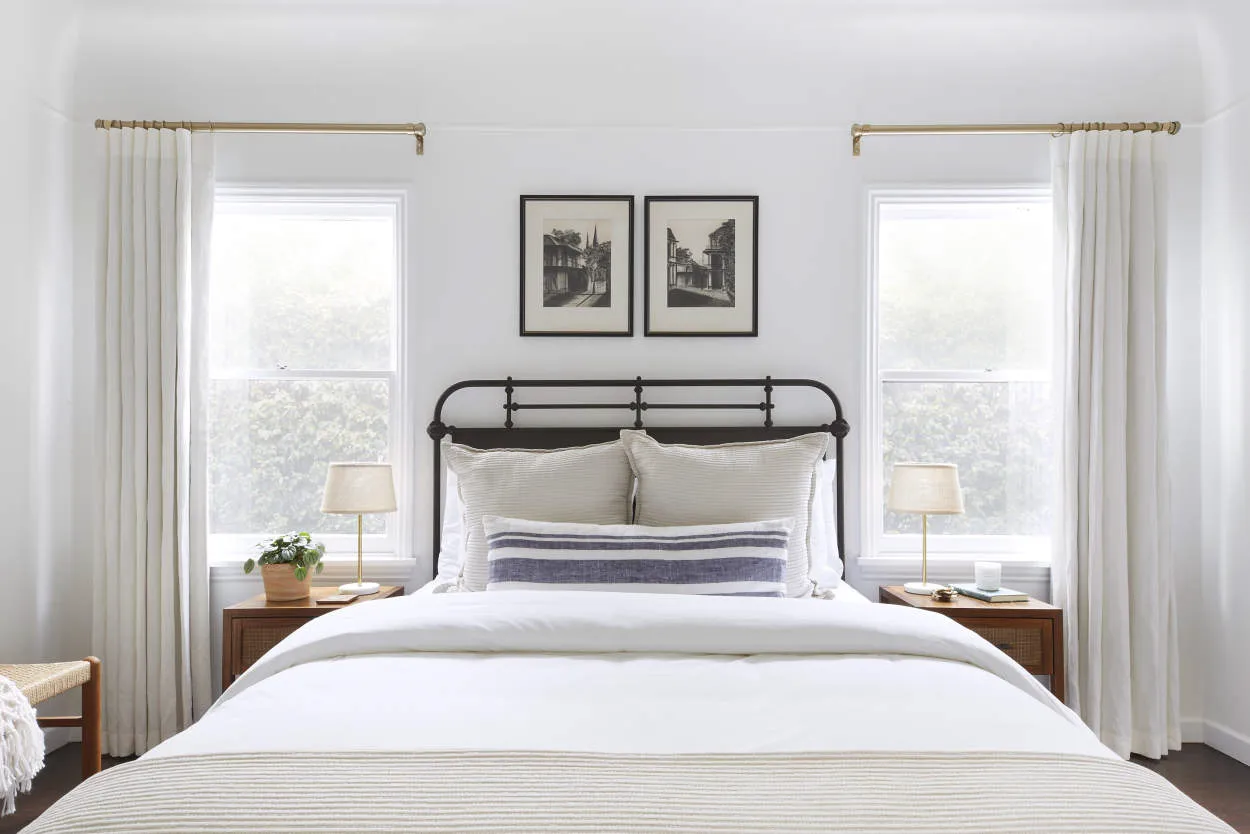Creating a Sleep Sanctuary: Advanced Bedroom Ideas
Optimizing Sleep Environment
Creating a peaceful and comfortable sleep environment is essential for a restful night’s sleep. By implementing advanced bedroom ideas, you can transform your bedroom into a sleep sanctuary that promotes deep, rejuvenating sleep. Here are some key elements to consider:
1. Lighting
Adjust the lighting in your bedroom to create a soothing atmosphere. Use dimmer switches or bedside lamps with warm, soft light. Avoid bright overhead lights before bedtime as they can disrupt melatonin production.
2. Noise Control
Minimize noise disturbances that can disrupt your sleep by using earplugs or a white noise machine. Consider soundproofing your bedroom walls and windows to reduce external noises.
3. Bedroom Temperature
Keep your bedroom at a cool, comfortable temperature. Optimal sleep temperature is typically between 60-67°F (15-19°C). Use a fan or air conditioner to cool the room if needed.
4. Comfortable Bed and Bedding
Your bed should be comfortable and supportive. Choose a mattress and pillows that match your preferred sleep position and provide adequate support. Additionally, use soft, breathable bedding materials for a cozy sleep experience.
5. Declutter and Organize
Avoid having clutter in your sleep environment. Keep your bedroom well-organized and free from distractions, allowing your mind to relax. Consider using storage solutions to keep items out of sight.
6. Scent and Aromatherapy
Incorporate calming scents like lavender, chamomile, or vanilla into your sleep environment. Use essential oils or scented candles to create a soothing ambiance that promotes relaxation.
7. Limit Electronic Devices
Avoid using electronic devices such as smartphones, tablets, or laptops in bed. The blue light emitted from these devices can interfere with your sleep-wake cycle. Create a bedtime routine that disconnects from screens before sleep.
By implementing these advanced bedroom ideas and optimizing your sleep environment, you can create a sleep sanctuary that promotes better sleep quality and overall well-being.
Soundproofing Techniques
Soundproofing your bedroom can greatly improve the quality of your sleep and create a peaceful sanctuary. Here are some advanced techniques to help you achieve a quieter and more restful environment:
1. Insulate your walls
One of the most effective ways to reduce noise is to insulate your walls. Adding insulation material, such as mineral wool or acoustic panels, can help dampen sound waves and prevent them from entering or leaving your bedroom.
2. Upgrade your windows
Windows are a common source of noise infiltration. Consider installing double or triple-pane windows with soundproofing properties. Additionally, using heavy curtains or shades can further block out unwanted noise.
3. Seal gaps and cracks
Search for any gaps or cracks in your bedroom walls, windows, or doors, as they can allow noise to seep through. Use weatherstripping or caulk to seal these openings and minimize sound transmission.
4. Use acoustic panels or foam
Acoustic panels or foam can absorb sound and reduce echoes in your bedroom. Install them on your walls or ceiling to create a more acoustically balanced space.
5. Add carpet or rugs
Hard flooring surfaces can amplify noise, while carpet or rugs can help absorb sound. Consider adding a thick rug or installing wall-to-wall carpeting to reduce noise levels in your bedroom.
6. Install a solid-core door
An ordinary hollow-core door may not provide sufficient sound insulation. Replace it with a solid-core door to block out more noise from the outside.
7. Use white noise
White noise machines or smartphone apps can mask outside sounds by producing a constant, soothing sound. This can help drown out disturbances and promote a more peaceful sleep environment.
8. Consider a soundproofing curtain
If external noise is an issue, invest in a soundproofing curtain. These specially designed curtains incorporate noise-absorbing materials and can significantly reduce outside noise.
By implementing these soundproofing techniques, you can create a sleep sanctuary in your bedroom, free from disruptive sounds and distractions. Start by identifying the sources of noise and then apply the appropriate solutions to enjoy a more peaceful and restful sleep.
Advanced Mattress Technologies
When it comes to creating a sleep sanctuary, investing in advanced mattress technologies can make a world of difference. A good mattress not only ensures comfort but also plays a vital role in promoting better sleep and overall well-being. Here are some advanced mattress technologies to consider:
1. Memory Foam Mattress
Memory foam mattresses are known for their ability to contour to the shape of your body, providing excellent support and pressure relief. This technology allows the mattress to respond to your body heat and evenly distribute your weight, reducing the likelihood of waking up with aches and pains.
2. Pocketed Coil Mattress
A pocketed coil mattress consists of individual coils wrapped in fabric pockets. This technology allows the coils to move independently, providing targeted support and minimizing motion transfer. Pocketed coil mattresses are ideal for couples as they can reduce disturbances caused by movements during sleep.
3. Latex Mattress
Latex mattresses are made from natural or synthetic latex foam. They are known for their durability, responsiveness, and breathability. Latex mattresses offer excellent support and can help alleviate pressure points, providing a comfortable and restful sleep experience.
4. Hybrid Mattress
A hybrid mattress combines the best of both worlds by combining different mattress technologies. Typically, it includes layers of memory foam, latex, and pocketed coils to provide the benefits of each technology. Hybrid mattresses offer a balance of comfort, support, and motion isolation.
Conclusion
Choosing the right mattress is essential for creating a sleep sanctuary. Advanced mattress technologies such as memory foam, pocketed coils, latex, and hybrid mattresses can enhance your sleep quality and contribute to overall well-being. Consider your personal preferences, body type, and sleeping patterns when selecting the best mattress for your needs.
Creating a Night Routine
Having a night routine is essential for a good night’s sleep and overall well-being. It helps signal to your body that it’s time to wind down and relax before bed. In this article, we will explore some effective strategies for creating a night routine that will help you achieve a restful and rejuvenating sleep experience.
1. Establish a Consistent Bedtime
Setting a consistent bedtime is crucial for regulating your body’s internal clock. Aim to go to bed at the same time every night, even on weekends. This consistency trains your brain to recognize when it’s time to wind down and prepares your body for sleep.
2. Create a Calming Environment
Your bedroom should be a sanctuary dedicated to sleep and relaxation. Consider using soft, neutral colors, comfortable bedding, and blackout curtains to create a calming atmosphere. Remove any distractions, such as electronic devices, and keep the room cool, dark, and quiet to promote optimal sleep.
3. Unplug from Technology
Electronic devices emit blue light, which can suppress the production of melatonin, the hormone that regulates sleep. To improve the quality of your sleep, disconnect from technology at least one hour before bed. Instead, engage in activities that promote relaxation, such as reading a book or practicing mindfulness exercises.
4. Establish a Wind-Down Routine
A wind-down routine helps transition your mind and body from wakefulness to sleep. Consider incorporating activities such as taking a warm bath, practicing gentle stretching or yoga, or listening to calming music. Find what works best for you and make it a regular part of your night routine.
5. Limit Stimulants and Heavy Meals
Consuming stimulants like caffeine and nicotine close to bedtime can disrupt your sleep. Avoid these substances, as well as heavy meals, within a few hours of going to bed. Opt for a light snack if necessary, but give your body time to digest before lying down.
6. Stick to a Relaxing Bedtime Ritual
A relaxing bedtime ritual can signal your brain that it’s time to sleep. This could include activities like journaling, practicing gratitude, or practicing deep breathing exercises. Experiment with different rituals until you find one that helps you unwind and relax.
Creating a night routine that promotes restful sleep is essential for your overall well-being. By establishing a consistent bedtime, creating a calming sleep environment, disconnecting from technology, incorporating a wind-down routine, avoiding stimulants and heavy meals, and adopting a relaxing bedtime ritual, you can create an ideal sleep sanctuary for yourself.
Aromatherapy for Better Sleep
Sleep plays a crucial role in our overall well-being and quality of life. Many factors can contribute to a restful night’s sleep, including creating a calming environment in your bedroom. One effective way to enhance the sleep environment is through the use of aromatherapy.
Aromatherapy involves using natural plant extracts, typically in the form of essential oils, to promote physical and psychological well-being. Certain scents have been found to have calming and relaxing effects, making them perfect for improving sleep quality. Here are some ways to incorporate aromatherapy into your bedtime routine:
1. Diffusing Essential Oils
One popular method of enjoying aromatherapy is by using essential oil diffusers. These devices disperse the scent throughout the room, creating a serene and fragrant atmosphere. Lavender, chamomile, and ylang-ylang are known for their soothing properties and can promote relaxation before sleep.
2. Pillow Sprays
Another way to incorporate aromatherapy into your sleep routine is by using pillow sprays. Simply spritz a light mist of essential oils onto your pillow before bedtime. The comforting scent will help calm your mind and prepare you for a peaceful sleep.
3. Bathing with Essential Oils
A warm bath can be incredibly relaxing, especially when infused with aromatic essential oils. Adding a few drops of lavender or Roman chamomile oil to your bathwater can create a calming and soothing experience, making it easier to unwind and drift off to sleep afterwards.
4. Massage with Essential Oils
Massage can be a great way to relax before bedtime. By combining the therapeutic benefits of touch with the calming effects of essential oils, you can create a deeply soothing experience. Look for massage oils that contain lavender, sandalwood, or bergamot for a tranquil massage session.
In conclusion, incorporating aromatherapy into your bedtime routine can contribute to a better sleep experience. By using essential oils through diffusers, pillow sprays, bathing, or massage, you can create a sleep sanctuary in your bedroom. Experiment with different scents and find the ones that work best for you to enjoy a more peaceful and rejuvenating sleep.
Conclusion
Creating a sleep sanctuary is essential for promoting quality sleep and overall well-being. By incorporating advanced bedroom ideas such as using calming colors, minimizing electronic devices, and investing in comfortable bedding, you can transform your bedroom into a peaceful retreat. Remember, a restful environment is key to achieving a good night’s sleep and waking up refreshed.




